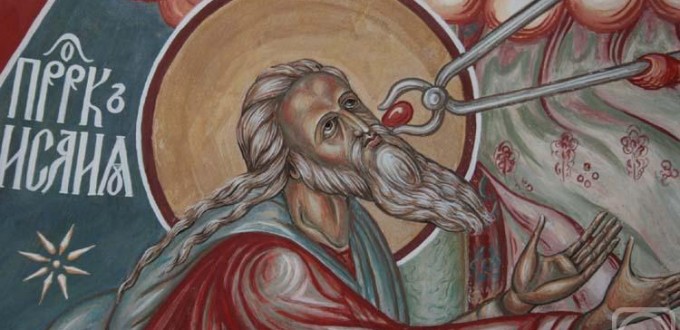By Curtis J. Mitch

If I asked you to identify passages in Sacred Scripture that speak about the Eucharist, what passages would come to mind? Perhaps the Last Supper accounts in the Gospels of Matthew, Mark, and Luke. Or maybe Jesus’s synagogue sermon on the Bread of Life in the sixth chapter of John’s Gospel. One might also cite St. Paul’s remarks on the sacrament in 1 Corinthians 10–11. But few of us, I suspect, would turn our thoughts to the Book of Isaiah.
The Fathers of the Church did exactly this, however. No doubt they had beautiful and insightful things to say about the New Testament passages mentioned above. But they also had eyes to see the mysteries of Christ in the Old Testament. One passage that grabbed their attentions was “the call of Isaiah” in Isaiah 6:1–13. In this text, Isaiah recounts the inaugural event that launched his long career as a prophet.
The setting is the Temple of Jerusalem in 740 B.C., the year that king Uzziah of Judah died. Isaiah finds himself in the house of worship and is granted a vision of the Lord, exalted and enthroned in majesty. He witnesses winged angels, called seraphim, ministering to the divine King as they call out to another: “Holy, holy, holy is the Lord of hosts” (Isa 6:3). The thunderous acclamation shakes the sanctuary down to its foundations (Isa 6:4). Isaiah is overwhelmed by this awesome display of God’s glory and his heart is stricken with fear. “Woe is me!” he cries, “I am lost . . . I am a man of unclean lips” (Isa 6:5).
At this point, one of the seraphim approaches Isaiah with “a burning coal” taken from the fires of the Temple altar (Isa 6:6). The angel proceeds to touch the prophet’s mouth with the glowing ember, saying: “Behold, this has touched your lips; your guilt is taken away, and your sin is forgiven” (Isa 6:7). All of a sudden, Isaiah’s fear melts away. The Lord asks whom he can send as a prophet to his people, and Isaiah steps forward with the unflinching response: “Here I am! Send me” (Isa 6:8). So it is that Isaiah is commissioned as a prophet and equipped to speak the word of the Lord
So what does any of this have to do with the Holy Eucharist? Quite a bit, it turns out.
Consider the words of St. Cyril of Alexandria, a brilliant theologian and Egyptian archbishop who died about A.D. 444. Discoursing on the spiritual meaning of the call of Isaiah, he says:
One of the seraphim is sent to Isaiah with a burning coal which he took from the altar with tongs. This is clearly a symbol of Christ, who, on our behalf, offered himself up to God the Father as a pure and unblemished spiritual sacrifice with a most pleasing fragrance. In the same way, Christ is received from the altar. We must, however, explain why Christ is like a burning coal. It is customary in Holy Scripture for the divine nature to be likened to fire. God appeared in this way to the people of Israel as they stood before the Lord at Horeb, which is Mount Sinai. [1]
A similar interpretation of the call of Isaiah is offered by St. John of Damascus, a priest and monk from Syria who lived at the Mar Saba monastery in Palestine until his death in A.D. 749. Insisting upon the actual presence of Christ’s body and blood in Blessed Sacrament, he exhorts communicants:
Wherefore, in all fear and with a pure conscience and undoubting faith let us approach . . . let us receive the body of the Crucified One. With eyes, lips, and faces turned toward it, let us receive the divine burning coal, so that the fire of the coal may be added to the desire within us to consume our sins and enlighten our hearts, and so that by this communion of the divine fire we may be set afire and deified. [2]
Here we have two of the ancient Greek Fathers discovering the same mystery in Isaiah 6. The literal sense of the passage—what the words mean in their original, historical context—is all about Isaiah’s encounter with the Lord in the eighth century B.C. But the spiritual sense of the passage—what this encounter prophetically signifies about Christ and his work of salvation—is about the glorious transformation that takes place in us when we receive the Lord Jesus in the Eucharist.
There are several dimensions to this mystery of the “burning coal.” First, according to the sacramental interpretation of Cyril and John, the purging of Isaiah’s unclean lips shows us that Holy Communion is a purifying encounter with the Lord. Receiving him on our lips has the effect of burning away our venial sins (CCC 1393–94). Second, the fire that touches Isaiah’s mouth shows us that Holy Communion is a deifying encounter with the Lord. The fire that glows in the ember is the divinity of Christ, and this is the gift that he communicates to us in the sacrament, enabling us to become “partakers of the divine nature” (2 Pet 1:4). Finally, the prophetic ministry entrusted to Isaiah suggests that Holy Communion is a commissioning encounter with the Lord. In other words, when we receive the sacramental coal from the Lord’s altar, we are equipped to bring the gospel to the world.
That, after all, is what the Eucharistic liturgy is ultimately about. It cleanses us and sanctifies us for a purpose—to go forth as witnesses to the living Word of God. It is called a Mass (Missa in Latin) because it concludes with a commissioning or sending forth (missio in Latin) of the faithful to fulfill God’s plan for their lives (CCC 1332).
[1] Commentary on Isaiah 6.6. Translation slightly adapted from Isaiah: Interpreted by Early Christian and Medieval Commentators, ed. and trans., Robert Louis Wilken with A. R. Christman and M. J. Hollerich, The Church’s Bible (Grand Rapids: Eerdmans, 2007), 82. [2] On the Orthodox Faith 4.13. Translation slightly adapted from Saint John of Damascus, Writings, trans. Frederic H. Chase, Jr., The Fathers of the Church, vol. 37 (Washington, DC: Catholic University of America Press, 1958), 359.
 Curtis Mitch is a writer, editor, and research fellow at the St. Paul Center. He has been a contributor to the popular apologetics series Catholic for a Reason (Emmaus Road Publishing); he has co-authored a commentary on the Gospel of Matthew with Edward Sri in the Catholic Commentary on Sacred Scripture series (Baker Academic); and he is the principal annotator and associate editor of the Ignatius Catholic Study Bible (Ignatius Press). He has also been a guest lecturer in theology at Franciscan University and an online instructor in theology for Catholic Distance University.
Curtis Mitch is a writer, editor, and research fellow at the St. Paul Center. He has been a contributor to the popular apologetics series Catholic for a Reason (Emmaus Road Publishing); he has co-authored a commentary on the Gospel of Matthew with Edward Sri in the Catholic Commentary on Sacred Scripture series (Baker Academic); and he is the principal annotator and associate editor of the Ignatius Catholic Study Bible (Ignatius Press). He has also been a guest lecturer in theology at Franciscan University and an online instructor in theology for Catholic Distance University.

